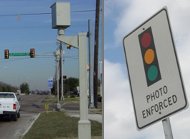12/16/2009
Analysis: Short Yellows Boost Revenue for Texas CitiesNine intersections with the shortest yellows in Texas saw a four-fold increase in their red light camera ticketing rate.

A number of Texas cities are exploiting short yellow timing at intersections, generating significant additional revenue, according to a review of Texas Department of Transportation (TxDOT) data by TheNewspaper. The citation issuance rate at the nine intersections with the shortest yellow timing in the state was four times greater than the ticket issuance rate at locations that offered yellow times exceeding statewide averages.
For example, among photo enforced intersections in Texas with a posted speed limit of 55 MPH, the average yellow time was 4.9 seconds. The city of El Paso, however, allowed an Australian company to set up a traffic camera at the intersection of Gateway North Boulevard and Woodrow Bean where the yellow was shorter by 0.4 seconds. This seemingly minor difference resulted in a 132 percent increase in the number of citations issued for every 10,000 vehicles entering into the intersection compared to the locations with longer yellow durations.
The difference was even more apparent among intersections with a 50 MPH speed limit where cities, on average, offered just under 4.5 seconds of yellow warning. In Coppell, the intersection of Belt Line Road and MacArthur Boulevard gave drivers a mere 3.5 seconds of yellow -- more than one second shorter than average. As a result, the location has been a significant producer, generating $862,275 worth of tickets from July 1, 2008 to June 30, 2009. The violation rate was nine times greater than intersections with above-average yellow timing.
At 45 MPH intersections, the average red light camera location offered 4.3 seconds of yellow time. That figure was too much for Houston, which offered a mere 3.6 seconds of yellow at US 59 South and Wilcrest Drive. This intersection's ticketing rate was 341 percent higher than the 45 MPH intersections statewide that had a longer yellow cycle.
At 40 MPH intersections, yellow times were generally set to last 4 seconds. Three camera-monitored intersections offered 0.4 seconds less of warning. In Corpus Christi, these included Greenwood and Gollihar in addition to Holly and Weber. In Houston, Fairbanks North Houston and US 290 had the shortest yellow. The average ticketing rate at these locations was 561 percent higher than locations that offered an above-average yellow time.
Most 35 MPH camera intersections offered slightly less than 3.9 seconds of yellow warning statewide. A trio of intersections had significantly shorter yellows. In Houston, Brazos and Elgin was set at just 3.2 seconds of yellow. The Dallas intersection of Beckley Avenue and Colorado Boulevard joined Cedar Hill's West Belt Line and Clark Road in offering 3.5 second yellows. The average ticketing rate at these locations was 39 percent higher than the more generous intersections.
The connection between short yellows and increased ticketing is well known. The Texas Transportation Institute concluded in 2004 that yellows shorter by a second than the ITE recommended amount generated a 110 percent jump in citations (view report). Conversely, increasing timing one second beyond the bare minimum decreased both violations and accidents.
The Texas cities mentioned above did not necessarily shorten yellow times following the installation of red light cameras. Documents obtained in a California court trial suggest that the far more common scenario is that the private vendor in charge of the photo ticketing targeted locations that already had short yellow times and high volume. The Institute for Transportation Engineers has encouraged local engineers to shorten yellows since the early '90s, before Texas cities began installing cameras.


